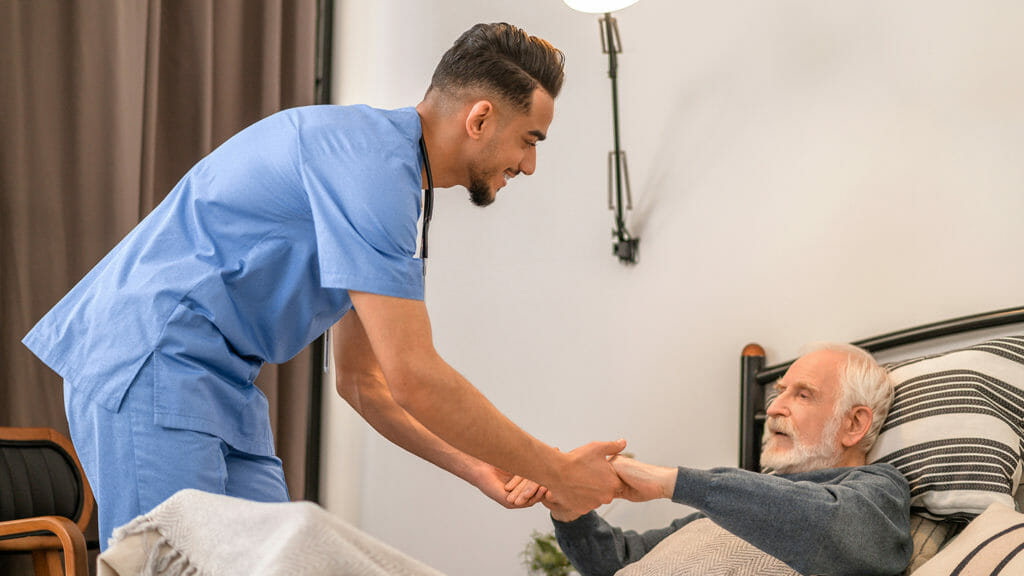There’s an inevitable fear many people experience when they’re about to be discharged from the hospital after a surgery or procedure. This feeling takes hold because most patients are still sick when they leave the hospital and require care, just not hospital-level care. In most cases, that responsibility falls on the patient themselves or a caregiver, with neither having any clinical education or experience.
This can have a snowball effect, creating physical and emotional distress for the patient and anxiety for the caregiver, which can lead to high readmission rates and even higher costs for payers. Ultimately, that innate fear of returning home post-procedure tends to circle back, and it impacts the entire healthcare ecosystem.
How we got here
When patients are in the hospital, their blood pressure, temperature, respiratory rate are all checked regularly. Their diet is controlled and their activity is limited by the instructions given by their care team. There’s no guesswork involved when a patient is still at the hospital; their sole focus is on following the instructions of their doctor.
All that changed with the advent of managed care in the 1980s, when payers began to look at the use of hospitalization with a more critical eye. Controls were put in place to lower the length of stays in hospitals. The belief then was that hospitals had a care function and a hotel function and the hotel function should be minimized. Hospitals are very expensive and not all that comfortable, so the idea of lowering the length of stay gained traction and the average length of stay for all hospitalizations decreased dramatically — from 11.4 days in 1975 to just six days in 2015. The COVID-19 epidemic has further decreased bed capacity, caused mainly by the labor shortage that are making hospitals feel more like hotels with no vacancy — where patients are diagnosed, treated and discharge to recover at home.
This results in people returning home sooner, sick and scared. The nurses and doctors who were available with a push of a button are no longer there to check on them. There’s no one walking with them to and from the bathroom. There’s no one there to make them meals or clean the dishes. Even worse, there’s no one to help change their bandages, adjust their tubes, or to remind them when and how much medication to take.
That fear they felt before and after being discharged is wholly justified. A total of 35 million people are admitted to hospitals in the United States annually, and at least two-thirds of them are discharged to self-care at home.[1] Patients feel abandoned and can get easily overwhelmed and stressed with the double duty of recovering and providing their own care, and this leads to about 20 percent of home-discharged patients being readmitted to the hospital, and more than a third transition to higher cost settings.[2]
The good news? Patients don’t have to feel alone when they leave the hospital to recover at home.
From hospital to home, but not alone
While the care team may no longer be physically there, patients should still feel supported throughout their at-home recovery journey. This requires a reeducation and a shift in mindset when we send patients home, and it’s the responsibility of their entire care team to remind them of what it’ll feel like:
- Returning home doesn’t mean you’re fully recovered: When you leave our care, the recovery process continues. You may still feel sick and sore, and you need to continue resting at home.
- Needing help is normal: You might feel weak, a little disoriented and nervous when you get home, and that’s OK. We can talk through your discharge instructions again if you have questions when you get home.
- Be patient with yourself: Everyone’s recovery journey is different. Try not to compare yourself to others or get overly concerned with what you read online.
Ensuring that patients have better access to nurses and doctors when questions do arise will help them feel less alone as well. For example, adding digital solutions with analytical capabilities to a care team’s arsenal allows them to better understand the current and potential state of their patients during the recovery process. This, in turn, helps them assess the type and level of support the patient will need at home, and based on this intel, coordination with payers is simplified as well, as they also gain insight into the support needed and assess the most cost-effective options available. With the right technology, patients can communicate more easily with their team while at home so that daily assessment can occur. Should the patient’s conditions change, notifications can be escalated to their doctor, who can provide necessary guidance or take action.
Here’s what this can look like in action: A patient who just had a first-time hip surgery is discharged from the hospital. They have a family member who is helping them return home safely and is setting them up with at-home physical therapy resources. They first have to tackle three flights of stairs, and they’re both nervous. The care team instructs them how to handle the trip home and checks in with them via a hospital-provided mobile app to ensure everything went smoothly. The patient reports that their hip feels tight and sore after the trip, so they ask if that’s normal and if they should come back in. Their contact reassures them this is normal, reminds them of the stretches that can alleviate the tightness, and reiterates that their team is on standby for any additional questions as they get settled.
It’s crucial to remember that leaving the hospital is highly stressful for patients (and their caregivers), but that stress is on a pendulum swing — it ultimately comes back to providers and payers, who literally and figuratively can’t afford to have them readmitted. Repairing the recovery journey is possible with the aid of technology, however, and it’s overdue time that we take action and make a change.
Alan Spiro, M.D., is president and chief medical officer of Laguna Health, a technology company that provides post-acute recovery solutions. Read his healthcare blog titled “Thoughts on Health, Wealth and Life.”



